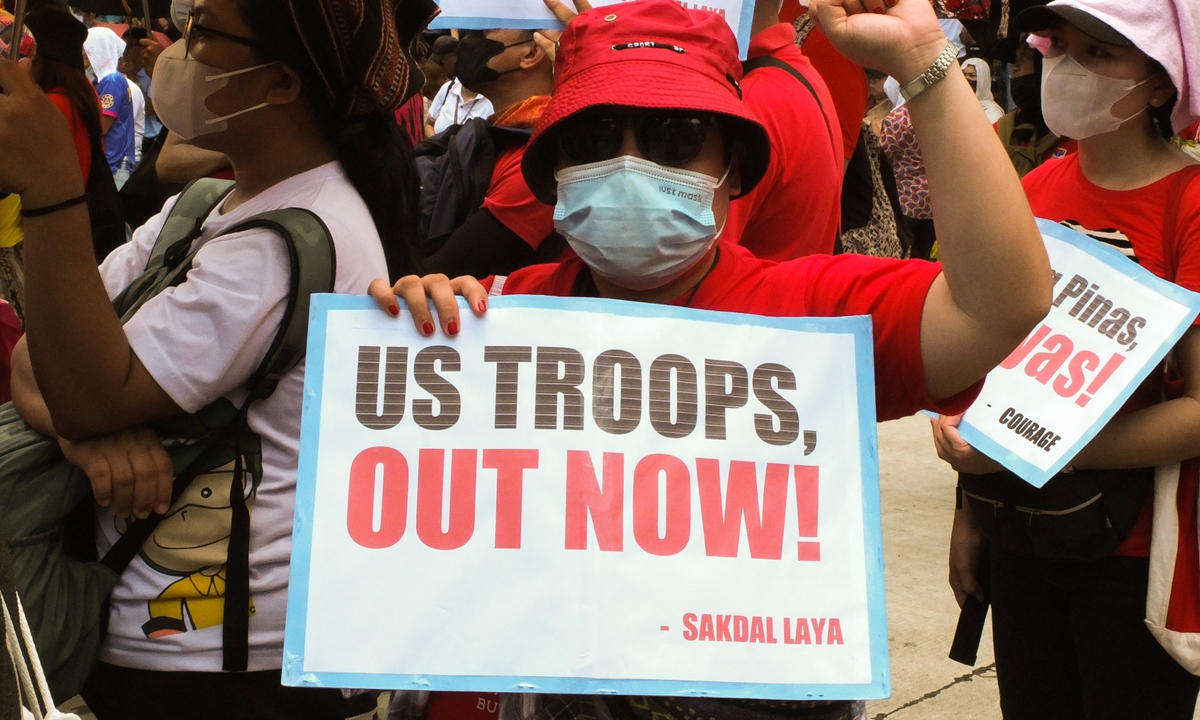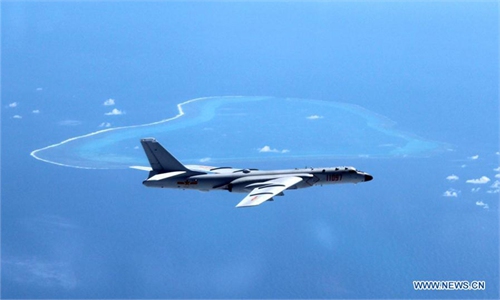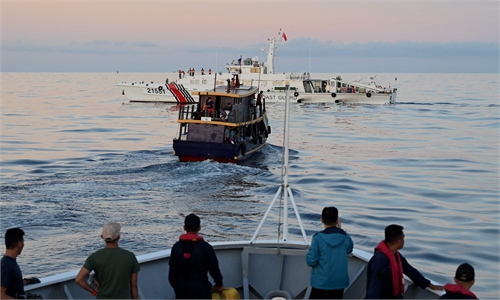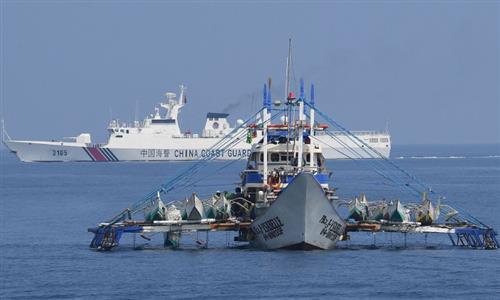Philippines-US ‘2+2’ meeting highlights ‘destructive role’ in Asia-Pacific peace, stability
Manila may ‘pay the price’ by blindly following US in countering China: experts

A protester holds a placard with the slogan calling the US troops to leave the Philippines during a demonstration in front of the US Embassy in Manila. File Photo: VCG
US Secretary of State Antony Blinken and Secretary of Defense Lloyd Austin on Tuesday met with Philippine Defense Secretary Gilberto Teodoro Jr and Secretary of Foreign Affairs Enrique Manalo in Quezon City during the "2+2" dialogue eyeing on boosting defense and security ties, as Blinken just concluded the Quad foreign ministers meeting in Tokyo where the "China-threat" rhetoric was once again hyped viv-a-vis the East China Sea and South China Sea issues.Analyst said the "2+2" dialogue between US and Philippines' top diplomats and defense chiefs shows that the US is promoting the Philippines as a proxy against China in the Asia-Pacific region, and tries to make Manila as a wedge to undermine the ASEAN unity, so as to better integrate its allies in forming an "Asia-Pacific NATO." China and the ASEAN member countries should be vigilant against the destructive role of the US and the Philippines.
The analysts also warned that it is not wise for Manila to blindly follow the US, which usually uses allies to the greatest extent possible to achieve its own goals and then abandons them at any time.
The "2+2" Ministerial Dialogue is the first such meeting that was hosted by the Philippines.
According to the joint statement released by the US after the talks, the secretaries from US and Philippines reiterated the importance of the security alliance and shared commitments under the 1951 United States-Philippines Mutual Defense Treaty.
The secretaries committed to deepen coordination on issues related to the South China Sea between and among their foreign and defense ministries.
The US announced it will allocate a $500 million military financing to help modernize the Philippine military and coast guard. It also said it has agreed to conclude an intelligence-sharing pact, known as GSOMIA, by the end of the year.
Besides, a "Roles, Missions, Capabilities Working Group" will be established to ensure more frequent and regular policy and operational coordination, and support strengthening bilateral planning and interoperability.
The two sides agreed to advance cybersecurity cooperation by investing in the cybersecurity capabilities of the Philippines.
Ding Duo, deputy director of the Institute of Maritime Law and Policy at China's National Institute for South China Sea Studies, told the Global Times on Tuesday the $500 million military financing is not provided to the Philippines free of charge, and that one-quarter of it will be invested into US' own military bases in the Philippines.
"In accordance with US' previous practice, the remaining part of the military financing will not be unconditional, and the US will raise a variety of specific and restrictive conditions and requirements," Ding noted.
Agreement reached during the "2+2" meeting shows that the Philippines and the US are promoting a deeper bonding on a strategic level, and continue to invest in regional militarization, Ding said.
At a time when the Philippines faces numerous problems in its domestic livelihood and economy, and has recently suffered heavy losses due to intensifying typhoon and monsoon rains, the $500 million military financing is highly ironic and raises the question of what is in real interests of the Filipino people, Ding noted.
Li Haidong, a professor at the China Foreign Affairs University, told the Global Times on Tuesday the US military commitment to Philippines is more about being symbolic and encouraging, paving the way for more possible military assistance in the future.
It's necessary for both China and the ASEAN members to remain vigilant against potential tensions and even crises in the South China Sea provoked by the Philippines, as well as the US destructive role to regional peace and stability, Li said.
Calculation and risk
Ahead of the "2+2" meeting, Philippines President Ferdinand Marcos Jr met with Blinken and Austin, and said that regular engagements between Manila and Washington were needed to ensure "agile" responses in terms of South China Sea situations, according to a Reuters report.
Following the meeting, US State Department spokesperson Matthew Miller said Blinken and Austin discussed with Marcos "their shared commitment to upholding international law in the South China Sea," and underscored US' "ironclad commitments" to Manila under the "Mutual Defense Treaty."
The US-Philippines "2+2" dialogue also followed the meeting between Chinese Foreign Minister Wang Yi and Philippine Foreign Secretary Enrique Manalo on July 26 in Laos, during which Wang said mutually beneficial cooperation and common development are in the fundamental interests of the two countries, and also warned Manila over the US intermediate missile system deployment.
After the China Coast Guard took regulatory measures against Philippine vessels' illegal intrusion into waters near China's Ren'ai Jiao on June 17, China and the Philippines have recently reached a temporary arrangement on the transportation and replenishment of humanitarian supplies to Ren'ai Jiao in order to maintain the stability of the maritime situation.
Wang Yi told Manalo that the Philippine side should fulfill its commitments and refrain from changing its position, otherwise, China will respond resolutely.
After the clash at Ren'ai Jiao in June between China and the Philippines, the US still wants to embolden Manila to stand up to China on the South China Sea issue, Li said
Besides turning the Philippines into a proxy against China in the Asia-Pacific region, Washington is also using Manila as an wedge to undermine the unity of ASEAN, and further integrate its allies in forming an "Asia-Pacific NATO," Li said. "The Philippines will be made use of to the maximum by the US."
According to the joint statement, senior officials from US and Philippines welcomed further defense and security coordination with Japan and Australia to address shared regional challenges.
Through military and security cooperation, the US is seeking a tight control of the Philippines in case Manila's foreign policy deviates from the US strategy or cannot meet the US interests, Ding said. "The US' logic is that the Philippines cannot and does not need to have an independent strategy," Ding remarked.
The Biden administration also tries to reassure its allies and to demonstrate that the leadership and commitment of the US are "counted," especially at a time when variables and chaos dominates the upcoming US election, Ding noted.
Earlier this month, former Philippines president Rodrigo Duterte criticized the Marcos administration for allowing itself to be "used" by the US in its own geopolitical rivalry with China, causing the worsening tension between Manila and Beijing, per the ABS-CBN report.
"By blindly leaning toward the US, the Philippines aims to satisfy its needs in territorial disputes with China," Li said. "But the US is not reliable … Playing major power game as a smaller country, [the smaller country] usually ends up with being played and sacrificed."
The Philippines' lack of understanding of the history of international relations and the brutal nature of great power competition has led the country's strategic elites to adopt a short-sighted and superficial policy, Li said.




